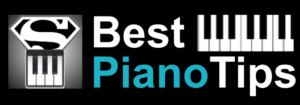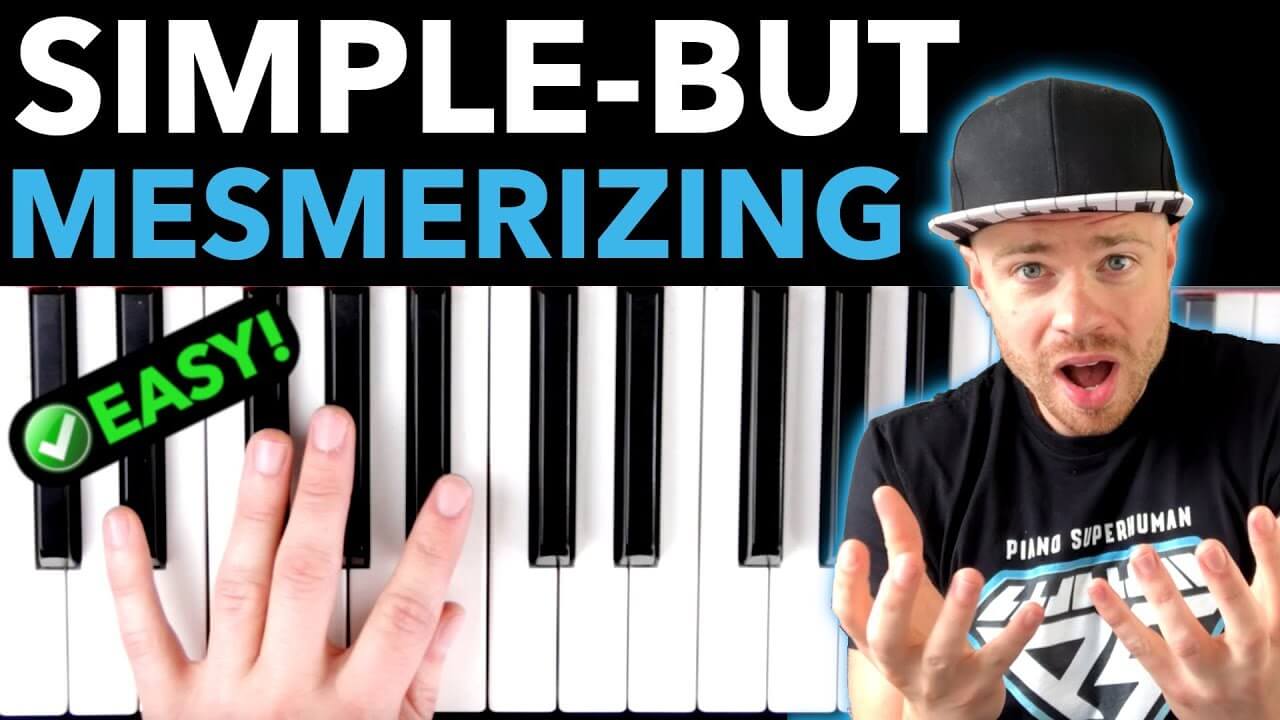What’s up my piano friends! Today you’re going to learn an absolutely mesmerizing right hand piano pattern that’s surprisingly simple to learn, especially for a beginner.
First, I’m going to teach you a version that’s so easy to learn even a kindergartner could learn it. It actually sounds really good even like that, but then we’re going to add variations to make it sound cooler, step-by-step. Read till the end of this blog post because at the end I’m going to tell you about a really cool trick where you can instantly multiple one pattern into four new patterns with zero extra practice on your part.
Alright, let’s get started!
Getting Started
In this video I show you a demonstration of this pattern. What you’re going to play is C major, G major, A minor, and F major. If you don’t know anything about chords, don’t worry, I’ll break it down step-by-step. We’re also going to go over how to switch this up with other chord progressions so you can learn any song, even if it uses different chords.
We’re going to start off in C position, with both of our thumbs on the C notes. Our other fingers will line up on the corresponding white notes next to them. Our hands for the beginner version will never leave these notes, so you don’t have to worry about shifting around or having to move your fingers up or down.
All we’re going to do for this lesson is simply alternate between the G and E notes over and over with our right hand.
Our left hand is going to play C, G, A minor, and F. The full thing is going to sound like this. You’ll notice that your right hand alternates four times while you’re playing. Once you get this sped up, it already sounds cool. There are already songs on the radio that use this exact pattern. Think about that, they’re so popular and famous they’re on the radio and they’re using this pattern.
This is step one. Before we go on to step two, we’re going to make it a little more challenging, but sound a lot cooler. I’m going to show you a little trick to make this come to life. We’re going to use the exact same notes, but use dynamics and tempo variation to make it come to life.
What I want you to do is at the beginning start off slow and soft. By the middle, you want to build up to loud and fast. Then, you build back down to slow and soft. If you know any kind of storytelling cycle or what they use for movies, they have an arc, and that’s what brings a piano pattern to life. This will sound something like this.
Playing it like I demonstrate in the video is a lot better than simply playing it all the same throughout. That’s what really makes this pattern mesmerizing and draws the audience in.
Making it Progressively Harder
Next, we’re going to make it a little bit harder, step-by-step, to make it sound a little cooler. We’re going to keep our left hand the same and our right hand is going to do some different notes and by the end of it, it’s going to sound like this.
To do all of this, we’re going to use a cheat sheet called the “Close Chords Cheat Sheet” that is going to help us out a lot. I could just show you the exact notes I’m playing now, but if I don’t show you how I figured out which notes to play, then when you have a song with different chords you’re not going to figure it out. So, I want to show you how I actually figured it out so you can do the same thing no matter what song you’re playing.
You can grab the cheat sheet here for free, just enter your name and email.
If you look at it, there are three different cheat sheets. Right now, all I want you to do is click on the close chords ultimate cheat sheet. This is going to bring you to a page that looks very complicated, but all it is is every single chord you’ll need to play every popular song and it gives you the major and minor chord and shows you a variation of the chord where your hand stays close together.
All we do is go to this close chords cheat sheet and we find the chord that we’re playing and whatever green notes are lit up, those are possible notes we’re allowed to play for the chord.
For example, going through the chord progression we just learned, we can go to C major. So, we find C major on the close chords cheat sheet, and we see that our three possible notes are C, E, and G. When we first played it, we used the notes G and E. We could also use the notes E and C. Furthermore, we could use G and C. We can pick any of those combinations to do our pattern.
So, for this example, let’s stick to what we did in the beginning, G and E. We’ll go to our close chords cheat sheet and find G major, where we see our options are B, D, and G. The only thing about the B, is that it’s going to be a little harder because it’s outside of our C position. For now, we’re not going to move our thumb, we’re just going to use the other two notes, G and D.
Now we move on to our next chord, A minor. We’ll go back to our cheat sheet, find A minor, and see that C, E, and A are possible notes. Which of these are in C position? E and C. So we’re not going to play the A note in this case. Now our whole chord progression looks like this.
Our last chord is F major, so we’ll go to our cheat sheet again, where we have the choice of C, F, and A. If we look at our C position with our hand again, the A is going to be outside so we’re going to play the C and F.
The next step is where it gets fun because now you can start being a little creative. Now you can go to your cheat sheet and pick different notes. You can mix it up and choose any two notes that work for you.
The important part about using the close chords cheat sheet is that I just showed you this very specific chord progression, but what about if you want to learn a song that has different chords? That’s what I want to teach you right now. We’re actually going to learn the song “Let It Go” from Frozen because everyone always requests that song.
How to Play “Let It Go”
All we have to do is go to Google, type in the name of the song + chords. For this example, we’d type “Frozen Let It Go Chords.” The first one that comes up has 5 stars and should be good because it’s from one of my favorite sites, ultimateguitar.com.
Once you click on the link, you’ll see all the chords to the song already laid out for you. You’ll notice the site is a little sloppy with all of the chord extensions listed as well, but you can just click on the simplify button and it’ll clean it all up for you so it’s easier to read. Any time the chord has a little “m” listed next to it, it just means that’s minor and if it doesn’t have the little “m” next to it we just assume it’s major.
All you have to do is use the close chords cheat sheet with these chords and you can play “Let It Go” from Frozen. The first chord is E minor, so we go to our cheat sheet and find E minor and we see that our notes are B, E, and G. We can play any two notes from these. The next chord is C major, so we’ll go to our cheat sheet again and find the C major chord. The notes for this one are C, E, G and we again can use any two of these three notes. The next chord is D major, and while we’ve never played this chord before, it doesn’t matter, we just go to our cheat sheet, find the chord, and see that the notes are A, D, and F#. A major is our next chord and the notes from our cheat sheet are C#, E, and A. You can watch me play the whole thing here.
Now we have our whole progression for the first four chords of the song. The best part? You can use this same process for any song! That’s why I really wanted to make sure I didn’t just show you the notes for the song, instead showing you exactly how I figured it out so you can do the same thing, applying it to any song you want.
One Last Variation
We’re going to add one more variation to make it even cooler. This one is going to take a little more practice because it is more intermediate or advanced level, but I wanted to show you what it’s like to take it to the next step.
The intermediate pattern is going to sound like this. You’ve probably heard the pattern before. It’s a very common pattern called “Rocking Chords.” All we do for this pattern is alternate the top two notes with the bottom note and these are the exact same chords on the close chords cheat sheet. You do this for the first chord, then the same thing for the next chord. You can do this for any chord. This is super common and super famous, especially in piano ballads.
How to Multiply Your Patterns
Now onto the fun part! I’m going to show you how you can multiply the pattern you just learned, even the beginner pattern, to 4 different patterns, with zero extra practice on your part.
All we’re going to do is shift this pattern up and down the keyboard. You simply take your thumbs, which were in C position for the original pattern, and move our thumbs to any two C positions on the keyboard. We can move up and play higher notes or down and play lower notes.
What a lot of people do is switch it up for the verse and the chorus. Maybe the verse starts up higher and quiet, while the chorus comes in louder and lower on the keyboard. Then, for verse two, they may move it even lower. You can mix it up throughout the song and play different octave ranges.
What I want you to do now is to get the free cheat sheet. Then, click on “bonuses” to get all of the PDF cheat sheets, including the one for this lesson.
I hope you liked this blog post! It took me a ton of time to put all of this together and I’d really appreciate it if you could subscribe to my YouTube channel for more lessons on learning to play piano.
If you’re really serious about learning piano, I do have a free Become a Piano Superhuman Course available which you should definitely check out too!

